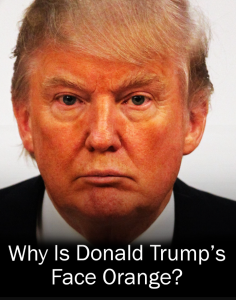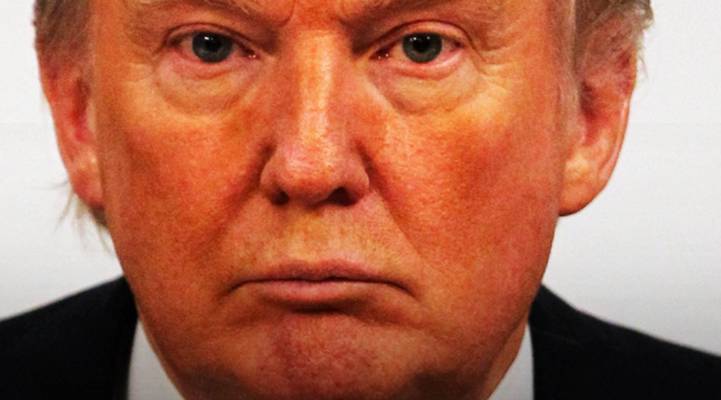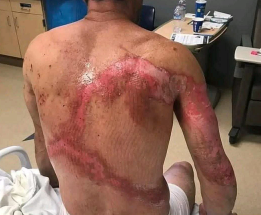Why Is Donald Trump So Orange? An Expert Thinks She Has the Answer
For years, one of the most recognizable features of Donald Trump has not been his business empire, his political rallies, or even his campaign slogans—it has been the distinct orange hue of his complexion. The former president’s coloring has inspired countless late-night jokes, internet memes, and speculation about whether it is intentional, accidental, or even medical. While Trump himself has offered only vague explanations, a growing body of commentary from makeup artists, photo editors, and image consultants sheds light on the mystery. Recently, one expert has suggested that the intensity of Trump’s bronzed skin may not just be cosmetic, but psychological, reflecting his state of stress and self-image at any given moment.
The Self-Tanner Theory
Perhaps the most common explanation is also the simplest: self-tanner. Spray tans and bronzing products are notorious for leaving uneven tones when applied without professional skill. A political makeup artist who worked at the Republican National Convention in 2016 noted that Trump’s appearance resembled the results of a tanning bed, complete with lighter patches around the eyes where goggles may have blocked exposure.
Dante Fitzpatrick, a professional from Beach Bum Tanning, explained that combining makeup with self-tanning requires precision. If applied poorly, especially in high-definition lighting, the result can exaggerate orange undertones. He suggested that Trump’s appearance is consistent with frequent use of bronzer layered over a base tan, a combination that can easily appear unnatural when cameras are unforgiving.
Doing It Himself
One detail that has repeatedly surfaced is that Trump often applies his own makeup. Veteran makeup artist Kriss Blevens claimed that, unlike many politicians who rely on professional stylists, Trump typically handles his own grooming. This could explain the streaks, uneven blending, and harsh demarcation lines often visible around his jawline.
A Vanity Fair report in 2019 supported this idea, revealing that Trump regularly dusts his face with translucent powder to cover redness associated with rosacea. If true, this practice would not only deepen his reliance on makeup but also increase the chance of clashing tones when paired with bronzers.
The Stress Connection
In 2024, photo editor Emily Elsie sparked conversation by suggesting a new angle: Trump’s complexion changes in correlation with his stress levels. By comparing images over several years, she noticed that his skin tone appeared lighter during calmer or victorious periods, such as after a favorable debate, but darker and more orange during times of political or personal strain.
Her theory is that Trump reaches for heavier bronzer when he feels insecure or under pressure, perhaps as a way of controlling his image. Lighting also plays a role: in cooler-toned environments, his makeup appears subdued, while under warmer lighting the orange tones intensify dramatically. Elsie argued that this was less about vanity alone and more about psychological behavior. Just as ordinary people might dress more formally when nervous, Trump may apply more bronzer when he feels his reputation is under attack.
Other Theories
Not all explanations are cosmetic.
Some observers have suggested medical reasons, pointing to Trump’s rosacea, a condition that causes facial redness. To mask it, he may use orange-tinted concealers, which are meant to neutralize redness but can exaggerate color under stage lights.
Others have speculated about dietary effects, such as eating large amounts of carrots or other beta-carotene-rich foods, which can in rare cases tint the skin. While humorous, this theory remains speculative and unsupported by evidence.
Still others argue that his coloring is a matter of stage management. Trump has long been particular about lighting at events. At one point, he blamed unflattering “bad lighting” in the White House for making him appear more orange than he believed he actually was. This explanation underscores how conscious he is of his public image, even if he rejects the idea that cosmetics play a role.
Professional Observations
Makeup artists who have analyzed Trump’s appearance generally agree on two points: first, that his look involves some combination of tanning and cosmetics, and second, that it is likely applied by Trump himself rather than an expert.
Safia Cox, a British makeup artist, argued that his skin tone comes from cream-based bronzers layered over a tanned base, topped with powders to reduce shine. She observed that during stressful campaign seasons, the orange tint deepens, reinforcing the theory that he modifies his appearance depending on his mental state.
Kay Montano, another professional, described his complexion as a “self-administered, semi-permanent spray tan with chalky matte powder.” She pointed to sharp edges along his jawline, the telltale sign of someone applying bronzer without careful blending.
Trump’s Own Words
When asked about his skin tone, Trump has usually brushed off questions. In 2019, one aide insisted that his look came from “good genes.” Trump himself has denied using tanning products or spray booths, though multiple staffers have contradicted this claim. At one point, Omarosa Manigault Newman alleged that Trump dismissed a staffer for improperly setting up a tanning bed, though this story remains anecdotal.
Regardless of the truth, Trump has consistently displayed irritation when his appearance becomes a subject of public conversation. He has blamed unflattering cameras, hostile press coverage, and even fluorescent lights for exaggerating his coloring.
Image, Identity, and Control
Why does Trump’s appearance matter? On one level, it is a trivial detail. But on another, it reveals the lengths to which public figures go to manage image in an age of constant scrutiny. Trump, who built a brand on projecting strength, confidence, and wealth, appears determined to maintain a carefully crafted look, even if it draws ridicule.
Emily Elsie’s theory of stress-driven bronzer application highlights the psychological stakes. She argues that his coloring reflects not just vanity, but a desire to control how he is perceived during moments of vulnerability. In this sense, the orange complexion becomes more than a cosmetic quirk—it is a symbol of the tension between self-image and public judgment.
A Cultural Phenomenon
Trump’s skin tone has become so iconic that it is now part of his caricature. Cartoonists, comedians, and even Halloween mask manufacturers exaggerate the orange glow as shorthand for his persona. While this has invited humor, it also illustrates how appearance can shape perception in politics. For some, the orange hue reinforces the idea of artificiality and excess; for others, it is simply a distraction from substantive debates.
Conclusion
Donald Trump’s orange complexion is likely the result of multiple factors: self-tanning products, makeup choices, rosacea management, lighting conditions, and perhaps psychological responses to stress. Expert observations suggest that the color varies with circumstances, becoming more intense when Trump feels embattled and lighter when he is riding high.
What makes the story compelling is not just the mystery of the hue itself, but what it reveals about image-making in politics. Trump’s face is a canvas on which his insecurities, strategies, and need for control are painted for the world to see. Whether deliberate or accidental, his orange glow has become inseparable from his identity—an enduring reminder that in the modern political theater, appearance is as much a performance as the words spoken on stage.


